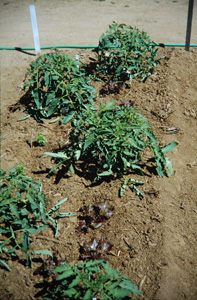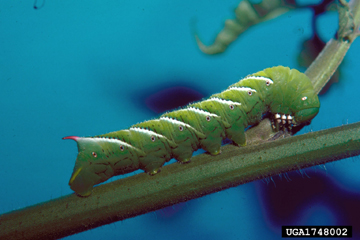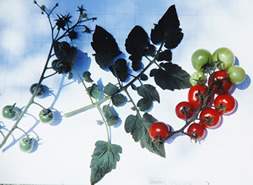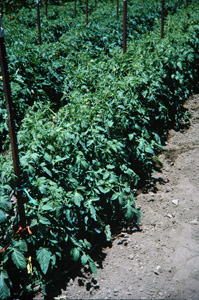Tomato
Because of genetic manipulation and natural selection there is a large range of tomato characteristics.
- Fruit size, shape, color and flavor
- Plant size, leaf shape and multiple disease resistance
- Acid and low-acid tomatoes
- Determinate and Indeterminate plants
- Heirloom, open-pollinated geographical selections
- Hybrid seed
The tomato is a warm season crop. The plant is temperature sensitive not only to frost but to high temperatures as well. The blossoms will drop off after several days in which temperatures fall below 55 degrees F. In many varieties, fruit will fail to set when daytime temperatures exceed 90 degrees F. for several days. Low light intensity and smog also limit fruit set.
DETERMINATE (bush) vs. INDETERMINATE (climbing)
A tomato variety is determinate if the vine terminates in a flower cluster. The plant makes only moderate vine growth after the fruit forms, making it possible to harvest the fruit in a single picking. Varieties with only one leaf between flower clusters are called Compact Determinate, whereas those with about 2 leaves between the fruit clusters are called Vigorous Determinate (e.g. Celebrity). Compact Determinate (e.g. Taxi or Tumbler Hybrid) have a concentrated early ripening and are good for container planting. Vigorous determinates have larger vines and less concentrated ripening and need some support in the garden.
Indeterminate varieties continue to vine even after fruit set and will continue to set fruit until killed by frost or disease. If grown without support, the plants will sprawl and take up a great deal of space. Most of the fruit will become sunburned without leaf cover. These large plants are less susceptible to leaf diseases such as Alternaria Blight due to the higher foliage to fruit ratio.
For best results in supporting Indeterminate plants, use concrete reinforcing wire to make large cages. Plants can grow above the top of a six-foot cage by several feet. Tie the cage to 2 or 3 stakes driven into the ground alongside the cage.
STARTING FROM SEED
Sow seed in containers six to eight weeks before plants are to be set out in the garden. Example: If you usually set out your tomato plants on April 15, start seed the first week in mid-February or March. Tomato seed germinates very slowly in cool soil. If possible, keep soil temperature between 75 and 80 degrees F. for quick germination. As soon as seedlings emerge, place them in a well-lit area at 60 - 70 degrees F. Fluorescent lights are best, two inches from the plant tops and turned on for 14 - 16 hours per day.
When true leaves develop and seedlings are about 1 1/2 inches tall, transplant into a 4 inch or larger container to produce large stocky transplants. From this point until setting out in the garden, 60 - 70 degrees F. is best. Water plants only enough to keep soil from drying out. Use diluted fish emulsion or a water-soluble complete fertilizer if the leaves begin to look purple or yellowish. Transplant into deeply dug soil, 18 - 24 inches apart for determinate varieties, 24 - 36 inches apart for indeterminate caged plants. After planting, water plants in with a high phosphate fertilizer solution or a seaweed extract solution.

For earliest plantings, set plants out under floating row-covers. Do not set unprotected plants out until night temperatures are above 45 degrees F. When fruit begins to set, place mulch under the plants to keep the soil from drying out too rapidly. Mulch also helps keep the fruit and leaves dry and clean. Early Determinate varieties are adversely affected by any check in growth and should not be started too early. Many of the early determinate varieties were developed in Idaho and Canada for cool, short growing seasons. Maturity dates from transplants are from 58 - 65 days. Some of these varieties do not do well in our area unless planted early (Jan/Feb) under row-covers and harvested before summer heat sets in. Northeastern seed companies carry these varieties.
NUTRITIONAL PROBLEMS are few unless there is a soil deficiency in one or more nutrients. According to the University of California Integrated Pest Management for Tomatoes, publication #3274, "Most agricultural soils in California contain enough nutrients to produce a tomato crop. Moderate amounts of nitrogen and phosphorus are usually all that is needed." However, due to San Diego County's unique growing conditions, some nutrient problems occur. Shallow hillside soil, using drip irrigation, small root systems, cool weather and heavy feeding can lead to nutritional imbalances. An over-supply of one nutrient can also lead to the limited uptake of others. Heavy fruit loads increase the plant's stress and deficiency symptoms appear. According to former UC Farm Advisor, Wayne Schrader, "The tomato plant uses large quantities of potassium during fruit development. Even a well-developed tomato root system cannot take up enough potassium to fulfill the plant's needs during fruit development. The potassium in older leaves is frequently cannibalized by the plant to meet the needs of the developing fruits. It is common, therefore, for tomato plants to show potassium deficiency symptoms during harvesting even though the potassium levels in the soil are more than adequate."
The physiological potassium deficiency (inter-veinal yellowing and necrosis on the lower leaves) is associated with heavy fruit loads. Other nutritional problems in the county are soft fruit caused by excess nitrogen and inadequate potassium or calcium uptake. Excessive nitrogen fertilizer can also contribute to blossom-end rot by stimulating too much vine growth that consumes calcium that should be available to the fruit. Tomato varieties differ considerably in susceptibility to blossom-end rot. In general, varieties with elongated fruit are more susceptible. Damage from end rot can be avoided or reduced by thoroughly watering a large area around each tomato so the plant will develop a large root system and minimize water stress.
VARIETIES
Choosing varieties for your garden can be based on an experimental approach or a more conservative one. When selecting varieties, remember our basic climatic conditions such as high summer temperatures, long growing season, high humidity in the spring, high light intensity in the fall and smog. In coastal areas, the marine influence is more conducive to root rots and leaf diseases. Only a few diseases are likely to be important regularly in a given area since climate and soil type influence their distribution.
Don't expect good results inland with varieties that were developed for cool, short season areas such as tomatoes with large double blossoms (e.g. Beefsteak or similar varieties). Varieties that do not have enough leaf cover to prevent sunburn and varieties without the more common disease resistance are all asking for trouble later on. Root Knot nematode infested soil is a common problem in the county. Be sure to use nematode resistant varieties and rotation of tomato-growing areas in the home garden. Celebrity, is an example of a disease resistant type. It is listed in catalogs with capital letters after the name such as V, F, N, T, A. The V stands for Verticillium wilt, F for Fusarium wilt, N for root knot nematodes, T for tobacco-mosaic virus and A for Alternaria blight. In cool coastal areas, use multi-resistant varieties like Celebrity, Champion and Better Boy. The variety, "San Diego" ,was developed for our county. Try it.
DISEASES
Some diseases are soil borne and caused by soil fungi that affect roots or other plant parts in contact with the soil such as Fusarium and Verticillium wilts and Phytophthora root rot. Diseases infecting above-ground plant parts can be carried by wind or water or in the case of viruses(tobacco mosaic). , they may be spread by insects or even mechanically by hand or other means. Infection by above-ground diseases often occur when plants are exposed to rain, fog, dew, or sprinkler irrigation. Some of these diseases are: Early blight, late blight, bacterial speck and gray and black mold. Many pathogens that affect tomatoes remain dormant in the soil for long periods of time and still can produce disease when tomatoes are replanted in affected soil. Avoid areas of poor drainage and compacted soil. Anything that makes water management difficult increases the chance of soil-borne disease.
Most viral diseases are spread by insects such as aphids, whiteflies, leafhoppers and thrips. In most cases, controlling the insect vector does not prevent the disease. Once an insect begins to feed, virus transmission occurs so rapidly that insecticides cannot kill the insect fast enough to stop that transmission. Some control of the insect vector can be done by removing specific weeds in surrounding uncultivated areas in which insects over-winter. Viral diseases include curly top, alfalfa mosaic, yellow top and spotted wilt. Tobacco mosaic is usually spread after infection mechanically, when plants are handled repeatedly for tying and picking.
INSECTS
Tomatoes are susceptible to various insects at each stage of growth but usually only 2 or 3 species are important in a season. The most destructive are worms that feed on the fruit. The next pests in importance are those that attack the seedlings such as cutworms, leaf beetles and green and pink aphids. Foliage pests are generally of secondary importance. The most damaging is the tomato russet mite that can severely damage plants in hot weather. The leafminer usually occurs in mid to late summer and can defoliate plants if population build-up has been caused by application of insecticides which kills the pest's natural enemies. Hornworms are usually not a problem in the home garden where handpicking is commonly done. They can alsobe controlled with products athat contain Bt (Bacillus thurengenseis)

Good reference catalogs for tomato varieties and seed purchase are the Tomato Supply Company (www.tomatogrowers.com) and Totally Tomatoes (www.totallytomato.com). Both are free.
Not all insects found on tomatoes are pests. Predators and parasites that attack specific pests are sometimes abundant and keep pests under control. Superficial feeding scars on fruit are of minor importance to home gardeners. See the University of California Extension publication #3332, Pests of the Garden and Small Farm. It can be purchased online at the University of California Agricultural and Natural Resources web site (http://anrcatalog.ucdavis.edu).
Tomatoes need deep watering on a regular schedule. The frequency depends on soil texture: sandy, loam or clay. You need to amend the soil if you have extremely sandy, decomposed granite or heavy clay soil. Use organic material like homemade compost or a bagged product like peat moss or other organic soil amendment.
The addition of organic matter to the soil increases the water-holding capacity in the case of sandy or loose soil and opens dense clay or heavy textured soil. In amended soil, the frequency of irrigation is modified and a good deep watering about once a week or every 5 days is a general rule. If the weather turns hot for several days or there is a Santa Ana condition, extra irrigation may be needed. A Tomato plant with full leaf cover and loaded with bloom and immature fruit cannot take water-stress for very long before showing signs of blossom-drop and blossom-end rot.
IRRIGATION SYSTEMS
Three methods of watering tomato plants are large basins around each plant, drip tape and soaker hose. The first, a hand watering method is probably the most commonly used. Its effectiveness depends on the gardener's time as each basin must be maintained with sides high enough to confine enough water, and the basin needs to be filled more than once to provide the amount the plant needs. Drip tape is the most efficient method especially if a simple timer is put in the line to turn the water off. On raised beds or on the flat ground, 2 drip tapes, one on each side of the plant are placed about a foot apart. Drip tape comes with holes on 8 inch spacing and provides 1 gallon per minute for each 100-foot length. Transplants are spaced alongside the tape, about 2-3 feet apart, if cages are used. Drip tape is a better choice if the garden beds are not on level ground as they have a pressure-compensating feature and give equal water at both ends of the row. Soaker hoses give a larger volume of water than drip and need to be regulated at the valve. They are not good on sloping ground as the far end of the hose will not give equal amounts of water compared to the head of the line.
Cherry Tomatoes
Cherry tomatoes are an important salad ingredient throughout the United States, and a reliable favorite in the home garden. Their culture is the same as other types of tomatoes, but their yield seems 'never ending'.

Plant sizes, fruit color and shape can vary from an eight-inch plant to a plant over six feet tall. Maturity dates from transplants vary from 55 days to 80 days. Fruit shapes, besides round, are described as oval, pear, grape and currant. Colors range from yellow, pink, cherry, white and a black-red.
The indeterminate type plants are trained for vertical growth for ease of picking, with eight-foot stakes and horizontal strings. Plants are spaced two feet apart in the row with two or three plants between stakes. "Horizontal strings of binder twine or plastic are used on both sides of the plants to hold them upright. Strings are stapled or wound around each stake. The first string is started about 18 inches above the ground with additional strings applied about every 12 inches as the plants increase in height." (University of California publication #2638)

Make sure there is good air circulation between rows if you grow more than one or two plants as they can become very dense bushes, which makes them susceptible to insects and disease.
The 2010 seed catalog from Tomato Growers' Supply (www.tomatogrowers.com) lists 34 varieties of cherry tomatoes!
Also check out ...
UC websites for the Vegetable Research and Information Center (http://vric.ucdavis.edu) and Integrated Pest Management (www.IPM.ucdavis.edu)
Planting Dates
Coastal:
Transplanting Dates for Tomatoes:
March - July
Inland:
April - June

